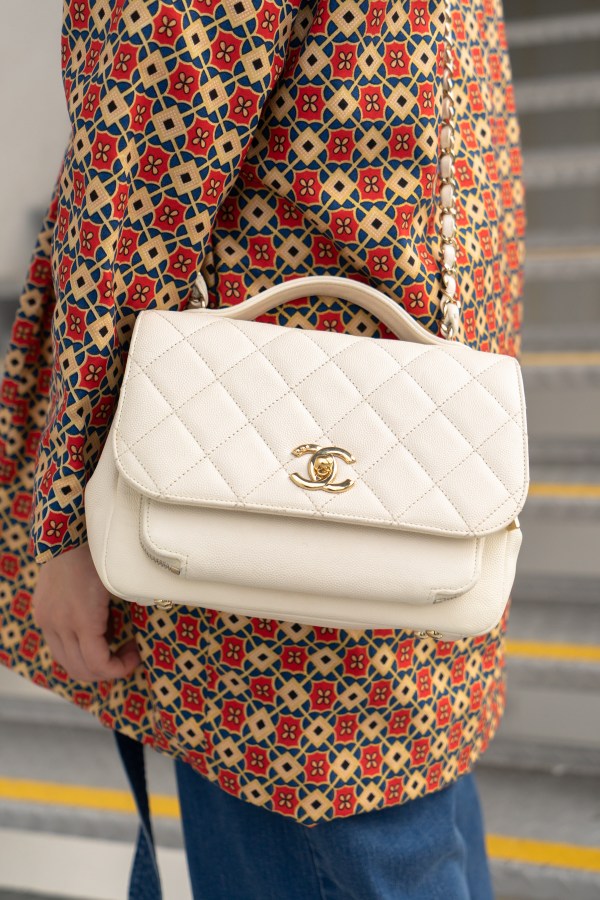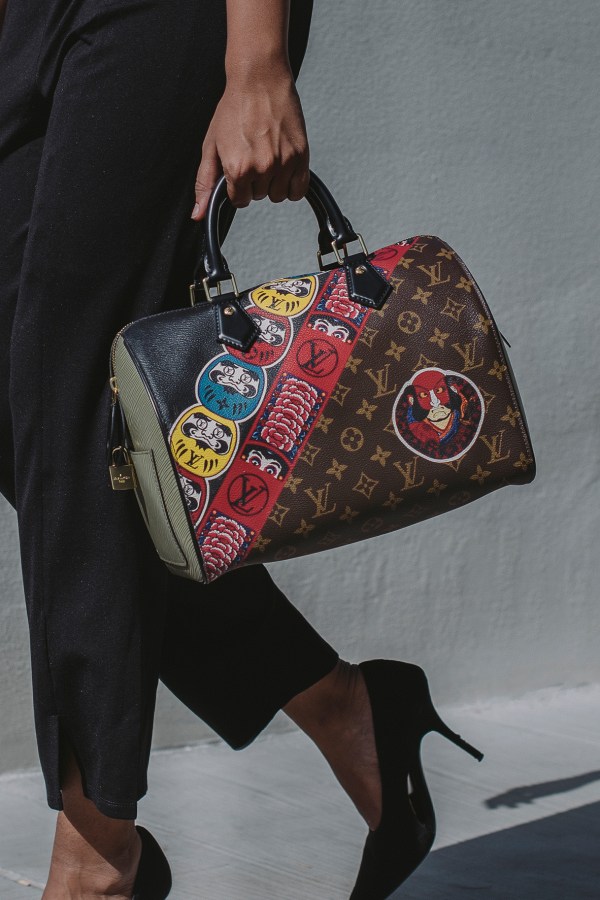You probably already know this: the fashion industry is rife with counterfeit products — fake brand logos plastered on phone cases and sneakers, cheap knock-offs and replicas, and on the other end of the spectrum: high-end Triple-A counterfeit designer bags, from coveted brands like Louis Vuitton, Hermès, Dior, Gucci and more. These designer bag replicas can be imitated so closely to the original that they’d fool even the most seasoned authentication experts on a bad day. How, then, can a regular consumer like you spot a counterfeit bag on your own?
We’ve got our Senior Buyer for Style Theory Bags, Brenda Ling, to share with us the insider tips that the Style theory Bags team uses to keep fake designer bags out of the Infinite Wardrobe, and how you can learn to spot a counterfeit bag on your own!
Name: Brenda Ling
Position: Senior Buyer
What I do: I’m the Senior Buyer for Style Theory’s Bags. My team and I manage all vendor relationships, merchandising-related planning and business decisions. We also look after the inventories for both our subscription and resale platforms to ensure the best condition and assortment of styles.

When it comes to spotting a counterfeit, what’s the general rule of thumb?
Do a little bit of research on the designer (or specific model, if possible) that you plan on purchasing, so you know what details to look out for, such as:
Label and stitching
The first thing you should take note of is the workmanship. Counterfeit bags tend to have poor or frayed stitching, and sometimes even glued seams. Authentic designer bags should have neat stitches that are even and symmetrical.
The designer label and logo stamp should also be straight with even spacing between the letters. Depending on the model, the colour of the stamp would usually match the colour of the hardware.

Hardware, such as zippers and screw heads
With exception to certain designers or newer styles with mixed coloured hardware, most other models should have hardware that is of one tone and finish. Chain hardware should also have some weight to them and shouldn’t feel hollow or light.
Zippers should be smooth when opening and closing. Some designers, such as Balenciaga (circa 2014), would also have their initials on the underside of the zipper heads.
Serial numbers
Look out for font, placement, presentation, and consistency of the manufacturing dates.
Similar to the label, the serial number, date and/or style codes should be straight and clearly printed. These alphanumeric codes usually indicate the location, date/season and model of the bag made. Do a bit of fact-finding to ensure the consistency of all the information — you shouldn’t be buying a bag with a serial code dated years before the model was launched!
Documents, tags, and packaging
Not all brands come with the same set of documents and packaging, so having extra cards or tags do not guarantee authenticity. Chanel, for example, comes with an authenticity card (which matches the serial number of the bag), but you will not expect to find such certification from Louis Vuitton.
Material and print
Real leather has a distinct smell that is difficult to replicate, and it would be a big giveaway if it smells of plastic or strong adhesives. Leather generally ages well, so even if you’re buying secondhand you shouldn’t expect the leather to be sticky or flaky.
If prints or monograms are used, make sure that they line up uniformly, even at the seams.

Chanel, Saint Laurent, and Louis Vuitton are some of the top brands in the Infinite Wardrobe. Do you have any tips on how to spot a real and fake designer bag from these brands?
Chanel
Regular Chanel quilting should have 11 stitches per diamond panel. It should be consistent all around the bag with no skipped stitches or loose threads.
The serial number in the bags are date coded and tells you the period the bag was manufactured. Bags made from around 2005 onwards would consist of 8 digits instead of 7.
Chanel’s serial numbers are unique to the bag. Counterfeiters tend to use the same serial number repeatedly, and two commonly used serial numbers amongst many are 10218184 and 14514163.

Saint Laurent
The ‘N’ and ‘T’ in Saint Laurent’s logo should be touching.
There should be 4 subtle nail heads on the logo hardware, the top 2 corners of ‘Y’ and at the ends of ‘S’ and ‘L’. Snap button sockets should also be engraved with ‘Saint Laurent Paris’.
If the bag comes with a chain strap, it should be a curb link that is slightly flat on both sides. In certain models (such as Kate), the chain comes with a rectangular metal connector with a logo embossed.

Louis Vuitton
The ‘O’ in Louis Vuitton’s logo should be round and not oval, and the ‘TT’ should be close together so that they almost look joined.
All bags should come with a date code hidden inside the pockets or along the seams. This 6 digit alphanumeric code indicates the location, week and year the bag was made. The first 2 alphabets represent the factory location, the 3rd and 5th digits represent the week (for models from 2007) or month (for models from the 1990s), and the 4th and 6th digits represent the year.
Taking a recent model with date code NZ2148 for example, ‘NZ’ indicates that this was made in Italy, and ‘2148’ indicates that this bag was made on the 24th week of the year 2018.
As Louis Vuitton is one of the most counterfeited brands in the market, these fakes tend to also come in many different models and colourways that the brand never created. Do check that the model and colour of the bag you’re buying actually exists!

While it might be easier to spot a counterfeit in real life, many secondhand sales take place online. What are your tips on spotting counterfeit bags online?
If you’re buying off a website, make sure they’re a reputable site with good authentication processes.
If you’re buying off an individual, ask for as many detailed images as you can and match it against the tips given above.
Check his/her sources: did they buy it from a boutique, or from another reseller? Do some research on how much the model usually sells for on the secondhand market as well — unless the bag has heavy wear and tear or is a very dated model, it’s likely to be a counterfeit if you’re getting a deal too good to be true.
How often does Style Theory Bags come across counterfeit bags received via our consignment platform?
We do receive counterfeit bags every couple of weeks. Some of them were bought from secondhand sources and the owners weren’t aware that it was a fake.
Chanel is the most common when it comes to copies, but we’re also seeing a rise in the new season Gucci models. Some were pretty easy to identify at first glance, either from the smell, the misaligned logo, or the feel of the leather. Others had to be put through a more detailed screening process.
Style Theory pairs Entrupy, an authentication service, with in-house experienced authentication experts. How do both work hand-in-hand during the authentication process?
Entrupy is an AI technology company with a database of information and images collected from their network of sources around the world. They make use of this database of information to create an algorithm that can differentiate between authentic and counterfeit items and is almost 100% accurate.
Style Theory’s authentication experts do the first round of visual screening to try to identify counterfeits. When it comes to pieces that are more difficult to authenticate, we scan and capture microscopic images on a device provided by Entrupy. It then compares the model, serial code, hardware (and even the stitches and grains of the leather) against their data to verify for consistency and authenticity.
The more we use the device, the more data is being collected by Entrupy, and the smarter the algorithm gets!
Read More: Bags Talk: Our Tools of the Trade Part I
What are the details of designer bags that are hardest to authenticate?
Across all brands, counterfeiters are getting better at mimicking authentic goods, so it gets harder to differentiate real from fake at first glance. However, if you know what to look out for and spend more time assessing the details, you’d be able to identify where they cut corners.
As a seller, how do you prove your bag is real with such a smart counterfeit market out there?
Follow these three simple “rules” of the playbook:
- Retain all original receipt and documentation if possible
- Seek out a third party authentication service for a certificate
- Share your newfound knowledge on authentication to assure the buyer that your bag is not a fake!
As they say, caveat emptor, or “let the buyer beware”, so use these tips to navigate the world of brand new or preloved designer bags with a keen eye!
Shop from our collection of preloved designer bags at the Style Theory Shop — it’s 100% authenticity guaranteed!
Looking to consign your designer bag for rental or for sale? We take care of your designer bags like our own, and with our strict authenticity checks and RFID tagging, you can rest assured that your very own designer bag will be returned to you whenever you want it back. Find out more about our consignment service here.







2 Comments
Bags Talk: Our Tools of The Trade Part I - Infinite Blog by Style Theory
June 29, 2020 at 9:21 pm[…] Read More: How to Spot a Counterfeit Bag, According to Our In-House Expert […]
Debunking 5 myths and misconceptions of preloved shopping
November 1, 2020 at 1:26 pm[…] For tips on spotting counterfeited items you can see here. […]